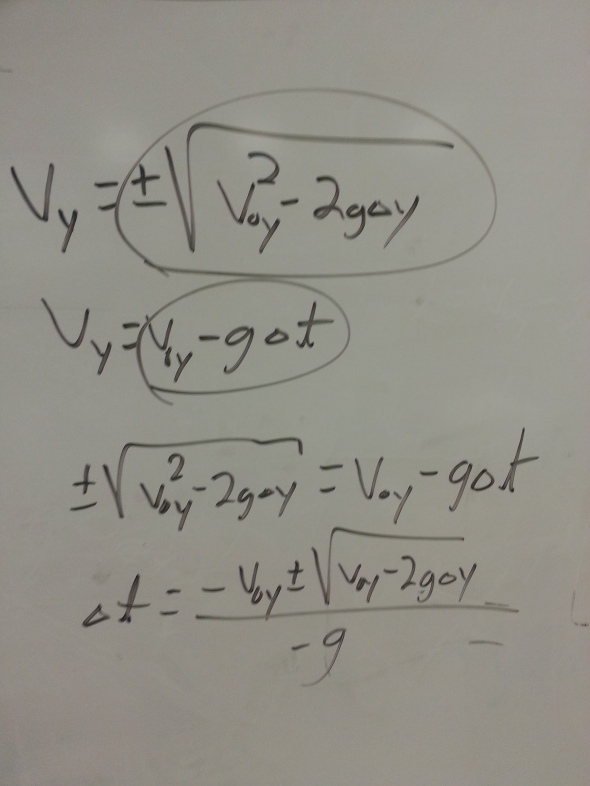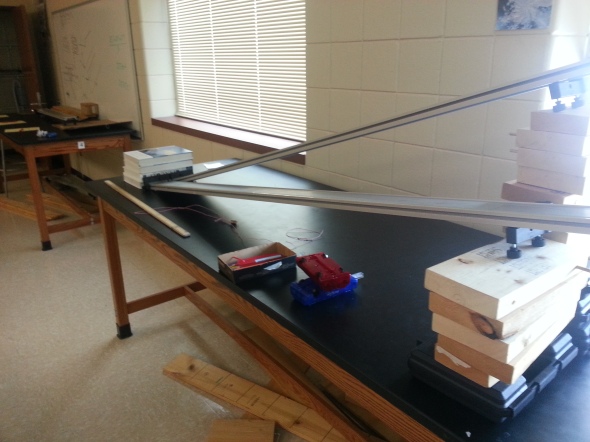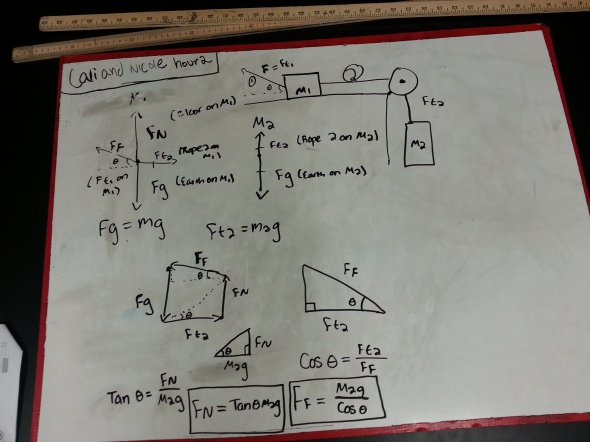Day 119: More on Problem Solving While Whiteboarding
Posted: May 8, 2014 Filed under: School Days | Tags: problem_solving, whiteboarding Leave a commentToday I did another round of what Frank suggested after a post on problem solving a month or so ago. I added a twist I really like. First half the groups work on one problem and half the other. I then had all the groups with the same problem get together to discuss it to make sure they knew what they were doing. then I had them pair with a group with the other problem and explain it to them, but nobody could write anything down. Finally I asked students to go work on the problem individually that was not the one they whiteboarded.
I love that this involved lots of conversation as well as a chance for students to try something on their own at the end. Tomorrow we’ll have some work time where I’ll check in with students individually to make sure they were able to solve their second problem on their own.
Day 115: Whiteboarding Problems
Posted: April 21, 2014 Filed under: School Days | Tags: MTM, problem_solving Leave a commentA couple weeks ago I lamented that I didn’t feel like I had good methods for whiteboarding difficult problems. I took some of the advice I received in the comments and skipped a couple easy MTM problems, then had half the class whiteboard one problem, the other half a different problem, then they explained it to each other. I then had one group present to the class for each problem as well to wrap it all up and make sure all students know how to solve it. I was happy with this method today, thanks to my PLN!
##MTM
Day 104: Current and Past Success
Posted: March 19, 2014 Filed under: School Days | Tags: problem_solving, whiteboarding 1 Comment
Yesterday I was a bit dismayed at how problem solving and whiteboarding was going. Then some people left some comments, and I tried what Frank suggested for problem 6a and b from Practice 3 here, and it was perfect. Particularly for this set of problems; the students were asked to first solve the problem using CAPM and UBFPM (constant acceleration and unbalanced forces), then to revisit it using energy. Instead I had half the class do one, half the other, then they paired up and explained their method to the other pair. After that I asked them to reconcile that the two equations were actually the same…which took a bit of rearranging or substituting slightly different variables, but they all got there eventually.
Yesterday and today helped me remember that I have seen some success (here and here) with getting kids to dialogue for problem solving, just not in the large group presentation style. That’s what’s been working for me, but I’m sure that will evolve as I get better at facilitating discussion (still got a ways to go, but happy with the progress so far). Thanks everyone for helping me out!
##whiteboarding
Day 103: Questions for the #modphys Community
Posted: March 18, 2014 Filed under: School Days | Tags: problem_solving 11 Comments
I feel like I’ve tried just about everything for problem solving in my college level physics class. This time around it was having the students work on problems yesterday (1-5 from this packet), then today we whiteboarded the problems. In my first period, we both played the mistake game and I had students in a circle. We had multiple groups with the same problem, presenting at the same time, and we compared whiteboards. In 2nd and 3rd hour I had them do more standard whiteboard presentations, as the circle didn’t feel right. In all cases, and in the many ways I’ve tried in the past to present problems on whiteboards, I didn’t feel like the time spent was worth it, particularly compared to simply having students simply work problems with me circulating, giving tips, and occasionally going through parts of the problem on the board.
This is as opposed to whiteboarding conceptual aspects; I see LOTS of benefit in those conversations.
So here’s my questions;
- Do you have a method for whiteboarding or otherwise going through the problem solving process that you have found to be successful?
- Do you think my method of having students work individually/together on problems in class, instead of whiteboarding them, is ok?
Comments are great, since we can have continued discussion, but twitter would be fine too. Thanks in advance for any help you can give me!
Day 78: Once Again, Kids Come Up with Good Ideas
Posted: January 14, 2014 Filed under: School Days | Tags: PMPM, problem_solving Leave a commentThe more I teach, the more I find I get stuck in a particular method of problem solving or diagraming I think works best. Over the course of the last two years with Modeling Instruction, I have found that as I steer kids to particular methods less and less, they come up with creative and elegant solutions more and more. Today was no exception.
We were solving a problem where a projectile is launched from a cliff and lands below the launch height, find the time of flight. My typical solution would be to find the time of flight via the quadratic formula from
A student brought up: Why don’t you just solve for in
and plug the solution into
? So we tried it, result below. Despite that it is using two equations, it’s actually easier than using the quadratic formula symbolically. I love my job.
Day 70: Group Exam
Posted: December 21, 2013 Filed under: School Days | Tags: problem_solving Leave a commentGroup exam, where students work on a context rich problem that is more difficult than that they would be expected to solve on their own. Part of the U of MN class I teach at the HS level.
Day 68: An Interesting Quiz
Posted: December 16, 2013 Filed under: School Days | Tags: practical, problem_solving, UBFPM 3 Comments
I stole another page from Kelly and set this lab practical up as a quiz. The students were told that I would give them both angles and the starting location of a cart on the steeper ramp; their job was to find a formula giving the location of the cart on the shallower ramp such that the carts hit the end stop at the same time.
This is great as a quiz for three main reasons
- It combines multiple models into an interesting problem
- If students get it wrong, they find out physically and can retry the problem if they have time
- It’s awesome to see physically when they get it right.
The picture below has students in the forefront plugging the given values into their formula to prepare for testing (hence the calculators), and students in the background looking at the solutions (yellow sheets), either they already tested correctly or they got stuck. I had a couple of students nail this who have been struggling. It is extremely satisfying seeing the carts hit in the right place.
***Note: This situation is fairly easy to get ‘right’ doing the wrong physics (or by just guessing with a ratio of angles). I always looked at their papers first, and if their answer was close to correct with the wrong work, I cheated and gave one cart a bit of a push at the release so they didn’t hit at the same time. I confessed this to the students later.
##labpractical ##ufpm
Day 56: Problem Solving
Posted: November 20, 2013 Filed under: School Days | Tags: BFPM, problem_solving Leave a comment
The kids had some pretty awesome problem solving going on today.
##BFPM ##representations
Day 50: They Continue to Blow Me Away
Posted: November 12, 2013 Filed under: School Days | Tags: BFPM, problem_solving Leave a comment
We have done very little problem solving with BFPM, so naturally I left my students to work on it themselves. I had an all-day meeting for science articulation, and the directions I left were for each group to whiteboard problem 2, circle up, debate and choose a best answer, take a picture and send it to me. Then repeat with problem 2. I can’t wait to check in with them tomorrow about how it went, specifically discussing 3b. Other classes below. Oh yeah, the problems are from Practice 3 here.



















